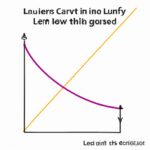The Gini coefficient is a widely used measure of income inequality. Calculating the Gini coefficient involves analyzing the distribution of income or wealth within a population. It ranges from 0 to 1, where 0 represents perfect equality, and 1 signifies extreme inequality. The formula for calculating the Gini coefficient involves plotting cumulative income against cumulative population on a Lorenz curve. The larger the area between the Lorenz curve and the line of perfect equality, the higher the Gini coefficient, indicating greater inequality. Understanding and calculating the Gini coefficient is crucial for assessing and addressing income disparities within societies.
(How to Calculate the Gini Coefficient)
The Gini coefficient is a measure of income inequality within a given population. It provides a numerical representation of the disparity between individuals or households in terms of their relative wealth or income distribution. The coefficient ranges between 0 and 1, with 0 indicating perfect equality (everyone has the same income) and 1 indicating perfect inequality (one individual or household has all the income). The calculation of the Gini coefficient involves plotting the Lorenz curve, which represents the cumulative proportion of the total income or wealth against the cumulative proportion of the population. To obtain the Gini coefficient, you need to compare the area between the Lorenz curve and the line of perfect equality (the 45-degree line) with the total area below the line of perfect equality. To calculate the Gini coefficient, you can follow these steps: 1. Arrange the individuals or households in ascending order based on their income or wealth. 2. Calculate the cumulative proportion of the population and the cumulative proportion of the total income or wealth for each individual or household. 3. Plot the Lorenz curve using the cumulative proportions. 4. Calculate the area between the Lorenz curve and the line of perfect equality. 5. Calculate the total area below the line of perfect equality. 6. Divide the area between the Lorenz curve and the line of perfect equality by the total area below the line of perfect equality. 7. Multiply the result by 100 to get the Gini coefficient as a percentage. It is important to note that the Gini coefficient is a relative measure of inequality and does not provide information about the absolute levels of wealth or income. Additionally, the interpretation of the Gini coefficient may differ depending on the context and the population being analyzed. By understanding the calculation of the Gini coefficient, researchers, policymakers, and others can gain insights into the level of income or wealth inequality within a given society, which can help guide efforts towards achieving more equitable distribution.Applications of Gini coefficient
Applications of Gini coefficient: 1. Income inequality analysis: One of the primary applications of the Gini coefficient is in measuring and analyzing income inequality within a population. By calculating the Gini coefficient, policymakers and researchers can gain insights into the distribution of income among individuals or households. This information is crucial for understanding the level of economic disparity in a society and can help inform policies aimed at reducing inequality. 2. Social welfare evaluation: The Gini coefficient is often used as a tool to assess the effectiveness of social welfare programs. By comparing the Gini coefficient before and after the implementation of a program, policymakers can evaluate its impact on income distribution. If the Gini coefficient decreases after the implementation of a program, it suggests that the program has been successful in reducing inequality and improving social welfare. 3. Economic development analysis: The Gini coefficient is also useful in the analysis of economic development. It allows researchers and policymakers to monitor changes in income distribution over time and across different regions or countries. By comparing Gini coefficients, one can identify areas with higher levels of inequality, which may require targeted interventions to promote inclusive economic growth. 4. Health inequality assessment: Another application of the Gini coefficient is in the evaluation of health inequality. By using health indicators such as life expectancy or access to healthcare services, researchers can calculate the Gini coefficient to quantify disparities in health outcomes. This information can help identify groups or regions that are disproportionately affected by poor health outcomes, leading to the development of targeted health policies. 5. Educational inequality measurement: The Gini coefficient can also be applied to assess educational inequality. By examining variables such as literacy rates, educational attainment, or access to quality education, researchers can calculate the Gini coefficient to gauge the level of educational disparities within a population. This information can assist policymakers in identifying areas that require intervention to promote equal access to education and improve overall educational outcomes. 6. International comparisons: The Gini coefficient is a standardized measure that allows for comparisons of income inequality across different countries. By calculating the Gini coefficient for multiple countries, researchers and policymakers can identify trends and patterns, enabling them to learn from best practices and implement effective policies to reduce inequality. In conclusion, the Gini coefficient is a versatile tool that has various applications in analyzing income inequality, evaluating social welfare programs, assessing economic development, measuring health and educational inequalities, and facilitating international comparisons. By utilizing this measure, policymakers can gain valuable insights to design interventions aimed at reducing inequality and promoting a more equitable society.
Definition of Gini coefficient
The Gini coefficient is a measure of inequality used to assess the distribution of income or wealth within a population. It provides a numerical representation of the degree of inequality, ranging from 0 to 1. A Gini coefficient of 0 signifies perfect equality, where every individual has an equal share of income or wealth, while a coefficient of 1 represents maximum inequality, where a single individual possesses all the income or wealth and everyone else has nothing. The Gini coefficient is commonly used in economics, sociology, and other social sciences to quantify and compare the levels of inequality between different countries, regions, or social groups. It helps policymakers and researchers understand societal disparities and assess the effectiveness of policies aimed at reducing inequality. The calculation of the Gini coefficient involves plotting a Lorenz curve. The Lorenz curve illustrates the cumulative proportion of income or wealth held by the cumulative percentage of the population. The Gini coefficient is derived by measuring the area between the Lorenz curve and a hypothetical line of perfect equality, which represents a situation where the distribution of income or wealth is completely equal. To calculate the Gini coefficient, data on the income or wealth distribution is required. The data is typically arranged in ascending order from the lowest to the highest value. The Lorenz curve is then plotted by calculating the cumulative percentage of the population against the cumulative percentage of income or wealth held. The area between the Lorenz curve and the line of perfect equality is then computed using mathematical integration, providing the Gini coefficient value. Interpreting the Gini coefficient involves understanding its numeric value in relation to the degree of inequality. As mentioned earlier, a coefficient of 0 represents perfect equality, indicating that everyone within the population has an equal share of income or wealth. On the other hand, a coefficient of 1 indicates extreme inequality, where one individual possesses all the income or wealth. It is important to note that the Gini coefficient has its limitations. It only provides a snapshot of inequality at a specific point in time and does not capture changes over time. Additionally, the Gini coefficient does not reveal the underlying causes of inequality, which can vary significantly across different contexts. In conclusion, the Gini coefficient is a useful tool for measuring and comparing inequality within a population. It enables policymakers and researchers to quantify the extent of income or wealth disparities and evaluate the effectiveness of policy interventions aimed at reducing inequality. However, it is essential to consider the limitations and context-specific factors when interpreting and utilizing the Gini coefficient.
Formula for calculating Gini coefficient
The Gini coefficient is a widely used measure of income inequality. It quantifies the extent to which a distribution of income deviates from perfect equality. The formula for calculating the Gini coefficient involves a simple but powerful mathematical expression. Let’s assume we have a population with n individuals and their incomes are denoted as X1, X2, …, Xn. The first step in calculating the Gini coefficient is to sort these incomes in ascending order. So, X1 is the smallest income, X2 is the second smallest, and so on, up to Xn, which is the largest income. Once the incomes are sorted, we create two new arrays. The first array, denoted as Ri, represents the cumulative proportion of the total income held by individuals with incomes up to Xi. The second array, denoted as Pi, represents the cumulative proportion of the population up to Xi. To calculate Ri, we use the following formula: Ri = (X1 + X2 + … + Xi) / (X1 + X2 + … + Xn) Similarly, Pi can be calculated using the formula: Pi = i / n After calculating both Ri and Pi for each income Xi, the Gini coefficient can be calculated using the following formula: Gini = 1 – Σ[(Ri + Ri-1) * (Pi – Pi-1)] Here, the summation is performed for i = 1 to n. It is worth noting that R0 and P0 are both equal to zero, so we can start the summation from i = 1. The resulting value of the Gini coefficient ranges from 0 to 1. A Gini coefficient of 0 represents perfect equality, where every individual in the population earns the same income. On the other hand, a Gini coefficient of 1 represents maximum inequality, where a single individual holds all the income and the rest have none. The formula for calculating the Gini coefficient provides a concise way to quantitatively measure income inequality. It takes into account the entire distribution of incomes within a population and provides a single number that summarizes the level of inequality. By understanding and utilizing this formula, policymakers and researchers can assess and compare income inequality across different populations and make informed decisions aimed at reducing inequality.
Interpreting Gini coefficient values
The Gini coefficient is a statistical measure used to assess income inequality within a population. It provides a numerical representation of income distribution where a value of 1 indicates maximum inequality and a value of 0 indicates perfect equality. Interpreting the Gini coefficient values can provide insights into the level of income disparity and social inequality present in a society. When determining the meaning of Gini coefficient values, it is important to consider the range of values that can be obtained. As mentioned earlier, a Gini coefficient of 0 represents perfect equality where all individuals within a population have an identical income, while a coefficient of 1 signifies maximum inequality where a single individual captures all the income and everyone else has none. Typically, Gini coefficient values within the range of 0.2 to 0.3 are considered low and indicate a relatively fair income distribution. In such societies, individuals have relatively equal access to resources and economic opportunities. Conversely, coefficients in the range of 0.3 to 0.4 indicate moderate inequality, suggesting that income concentration is slightly skewed towards certain individuals or groups. Gini coefficients between 0.4 and 0.5 are considered high and point to a significant level of income inequality. In these societies, wealth is concentrated among a small percentage of the population, leading to disparities in access to basic necessities, education, healthcare, and other essential resources. Furthermore, socio-economic mobility may be limited, as individuals from disadvantaged backgrounds find it difficult to improve their circumstances. When the Gini coefficient surpasses 0.5, it signifies severe income inequality, often associated with social unrest, political instability, and economic inefficiency. In these cases, a substantial proportion of the national income is controlled by a select few, leaving the majority of the population struggling to meet their basic needs. It should be noted that the Gini coefficient alone cannot provide a complete picture of income inequality within a society. It is essential to use additional data, such as poverty rates, unemployment rates, and wage differentials, to get a comprehensive understanding of the income distribution dynamics. Moreover, comparing Gini coefficients over time or between different regions or countries can be insightful. Tracking changes in the coefficient can help assess the effectiveness of policies aimed at reducing income inequality and inform decision-making processes. In conclusion, interpreting Gini coefficient values is crucial for understanding income inequality dynamics within a society. Gini coefficients ranging from 0 to 1 provide insights into the level of income disparity, with higher values indicating greater inequality. By considering additional socioeconomic indicators and analyzing trends over time, policymakers can develop strategies to address income inequality and promote a more equitable society.
Limitations of Gini coefficient.
The Gini coefficient is a commonly used tool for measuring income inequality and wealth distribution within a population. While it provides valuable insights into the level and pattern of economic disparities, it has several limitations that should be considered when interpreting its results. Here are some key limitations of the Gini coefficient: 1. Lack of sensitivity to extremes: The Gini coefficient focuses on relative income differences rather than absolute income levels. It does not consider the specific values of the highest and lowest incomes, which means it may not fully capture the extent of inequality when extreme disparities exist. In other words, it may not adequately reflect the concentration of wealth in the hands of a few individuals or the plight of those living in extreme poverty. 2. Ignores non-income indicators: The Gini coefficient only takes into account income disparities and overlooks other dimensions of inequality, such as access to education, healthcare, and basic services. Consequently, it provides a narrow view of overall well-being and social inequality within a society. For a comprehensive analysis, it is important to consider these non-income indicators alongside the Gini coefficient. 3. Lack of regional or subgroup analysis: The Gini coefficient provides an aggregate measure of inequality for an entire population, but it does not provide insights into regional or subgroup disparities. In countries with significant variations in income distribution across different regions or social groups, these disparities may be masked by the overall Gini coefficient. Therefore, additional analysis is often necessary to understand the nuances of inequality at more granular levels. 4. Ignores the source of income: The Gini coefficient does not take into account the source of income, whether it is earned through labor, investments, or public transfers. This omission can be significant as it does not differentiate between income derived from productive activities and income received through inheritances or other passive means. Consequently, it may not capture the full picture of economic inequality and its underlying causes. 5. Limited focus on the middle class: The Gini coefficient does not provide detailed information about the middle-income group, which can be important for understanding the dynamics of an economy. It primarily focuses on the extremes of the income distribution, leaving the middle segment largely unaccounted for. In economies with a significant middle class, additional measures may be needed to examine their economic well-being and potential vulnerabilities. 6. Sensitivity to population size: The Gini coefficient can be influenced by the population size being analyzed. Smaller populations may have more extreme coefficients due to the limited number of observations, while larger populations may have more stable coefficients. This sensitivity to population size can make cross-country comparisons challenging, especially when dealing with countries of vastly different sizes. To summarize, while the Gini coefficient is a useful tool for measuring income inequality, it has limitations that must be recognized. It is sensitive to extremes, ignores non-income indicators, lacks regional or subgroup analysis, does not consider the source of income, has limited focus on the middle class, and can be influenced by population size. These limitations highlight the need to supplement the Gini coefficient with additional analysis and indicators to gain a more comprehensive understanding of inequality in a given society.












